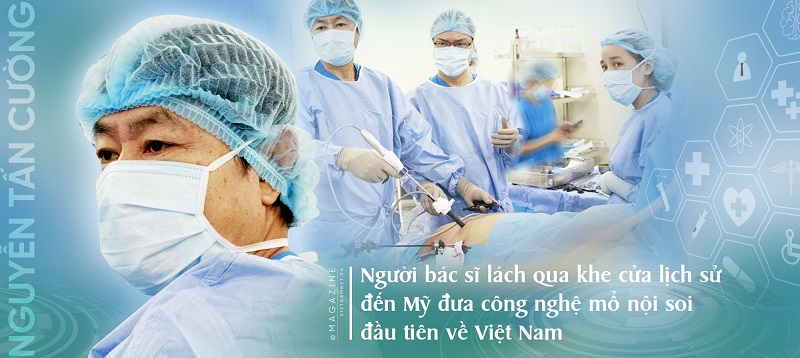
Vietnamnet - The pioneering doctor in the new field of medicine is like a person going into the jungle in search of treasure ... 29 years ago, Associate Professor Nguyen Tan Cuong came to America to study. At that time, medical facilities were still lacking sutures, but Assoc. Prof. Nguyen Tan Cuong brought back an endoscope worth $ 40,000, opening a new horizon for the medical field.
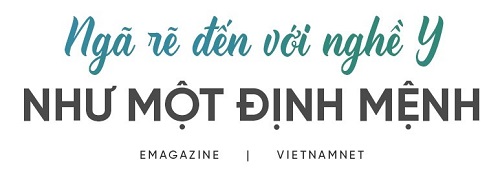
In the early 70s, a young talented doctor named Nguyen Tan Cuong was fascinated with science pursuing his dream studying New Zealand. However, during the war and the making of a chaos state, his dream had to be put behind and the young man entered University of Science.
In 1973, he saw his friends took the entrance exam to Saigon Medical School, so he took the exam and passed. The learning was a little interrupted when the country was reunified in 1975. By 1979, he was kept in school to teach Foreign Studies at Cho Ray.
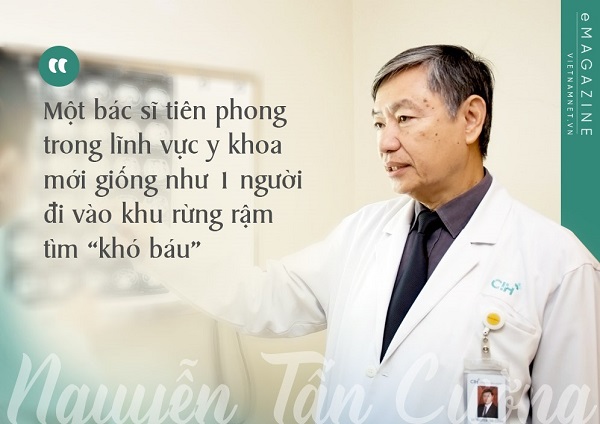
Incidentally in 1991, the Organization of the US-Vietnam Scientific Cooperation Committee held an English exam in Ho Chi Minh City (a small meeting but the two countries did not resume the diplomacy and were still embargoed), Dr. Cuong attended. The exam just wants to test English after years of forgetting. Good test results have helped Dr. Cuong get a scholarship to study in the US for a year. A sudden and too big present, Dr. Cuong went home and got permission. However, going to the US at this time was unprecedented, the school had to meet with the Party Committee, the delegation, the school administration, the medical department. Many people wonder, because the two countries' relations were not yet opened, Dr. Cuong's family also had many brothers and sisters residing in the US and Canada. Will sending doctors to go to school? A lot of issues are put up and put down in many meetings.
While the school is afraid of young cadres going to school, they are afraid of losing people. Professor Truong Cong Trung, principal, dean of medicine, head of the department of foreign medicine at the time, said: “If he finishes studying in the US, we will lose 1 regular officer, if he comes back we will have a good cadre ”.
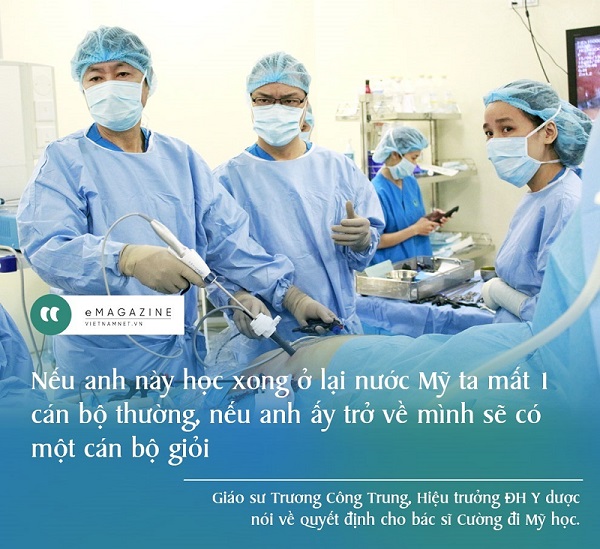
Going through many challenging steps and strict procedures from the Ministry of Foreign Affairs, the Ministry of Home Affairs, Dr. Cuong finally arrived in the US.
Assoc. Prof. Dr. Nguyen Tan Cuong recalled: “At that time, I was innocent and innocent, I just wanted to go to learn and expand new things, but I did not care at all in that rich country. Because, in Vietnam, I have a mother, my mother sacrificed me to go to school when my father died early and I never stayed in the US after studying. ”

Dr. Cuong set foot in Indiana state and spent 3 months working as an intern to observe and assist surgery in hospitals. There, he had the opportunity to meet Dr. Maurice Arregui, a pioneer physician in American laparoscopy.
At the end of the 3-month course, thanks to the spirit of eagerness to study, Dr. Cuong was recommended by Mr. Maurice Arregui to stay until the end of the year and work as his personal assistant.
In late 1991, the United States held a Scientific Conference, an exhibition displaying modern endoscopic surgical instruments. Here, the manufacturer questions the guy from Vietnam about the possibility of applying this new technique to treatment. However, the young Vietnamese doctor shook his head and replied, "I really want to, but it may take 10 years before we can put this into service for surgical treatment. Because, the current situation is still too difficult, the needle is just lacking a situation worth a laparoscopic surgery tens of thousands of dollars.
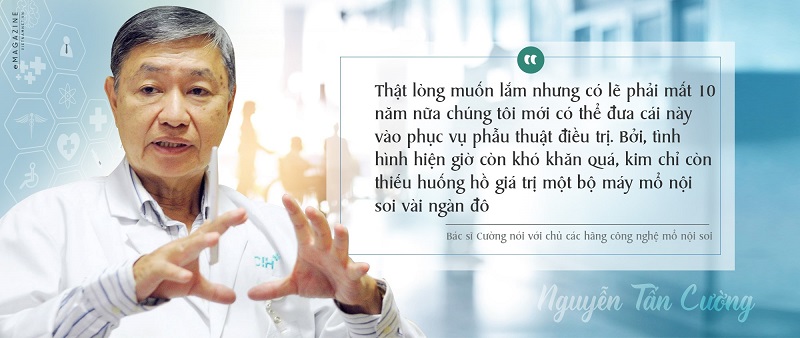
A few weeks later, Doctor Cuong prepared a towel to return home when he received a call from the manufacturer to offer a whole endoscopic apparatus worth USD 40,000.
Giving the machine more precious gold, but to bring back to Vietnam is a headache problem. “I went to school to work with no money, my 60-kg luggage, especially my suitcase was enough to cover the machine to more than 100 kg. Bringing home was a problem, ” told Dr. Cuong.
We have to rely on overseas Vietnamese to visit our hometown, send a few hitchhikers each, the first new laparoscopy system has just arrived in Vietnam.
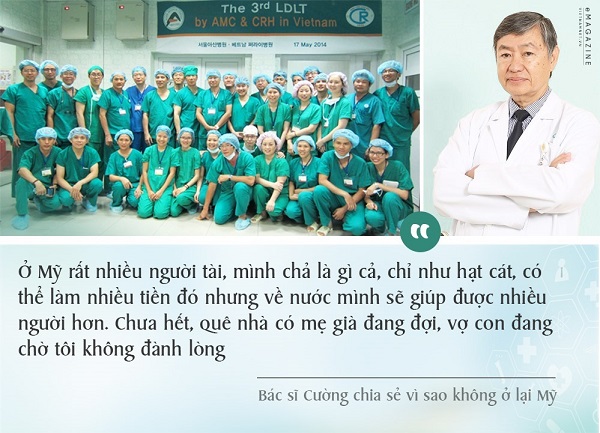
When asked about the open opportunities to work in the US for more income and conditions, he replied, “In America, many talented people, I am nothing but just a grain of sand, can make that much money but about our country will help more people. And yet, my hometown has an old mother waiting, my wife and children are waiting for me."

Getting the laparoscopy apparatus into practice is a problem, and it's much harder to apply to surgery. After returning home, Dr. Cuong immediately reported to the school, showing about laparoscopic surgery, wishing to apply it to Vietnam. But at that time, school leaders did not dare to take risks, because Vietnamese doctors had been used to open surgery for a long time. To be safe, the school decided to give Dr. Cuong 10 dogs to perform surgical operations on animals before being put into operation for patients.
Six months after the animal experiments, reporting to the school board of professors, Dr. Cuong's laparoscopy technique was accepted and introduced to Cho Ray Hospital for application.
The doctor remembered the memory, the first patient was a 63 year old woman. She had pancreatitis due to perennial gallstones, the pain of constant torture, but she was afraid of coming to the operating table when she heard of surgery. There was a family member working at Cho Ray Hospital. She knew about the new laparoscopic surgery technique, small wound, little pain, quick recovery, she decided to register for laparoscopic surgery.
On September 23, 1992, the female patient was the first laparoscopic surgery performed by Dr. Cuong himself. He naturally became the first laparoscopic surgeon in Vietnam.
After the patient recovered well, Dr. Cuong saw the potential of laparoscopic technology, one laparoscopic cholecystectomy only takes 24-48 hours for patients to be discharged, while previously patients takes a week. Since then, Dr. Cuong has built a team specialized in laparoscopic surgery, reducing the pressure on hospital overload.
Two years later, the US lifted its embargo, Japan began to provide aid and many hospitals began investing in laparoscopic surgery, and Cuong's team became the core instructors instructing doctors in Hospitals of neighboring provinces and Mekong Delta. There have been thousands of cases of laparoscopic surgery in a time when it was very difficult, the needle and thread did not exist.

After more than 34 years as a doctor, 8 years as the head of the Department of Hepatobiliary at Cho Ray Hospital, then teaching at the University of Medicine and Pharmacy, the happiest thing he shared was to both treat patients directly and teach at the same time. fire science research for students.
The strength of Dr. Cuong's happiness was that when he was the Dean of Cho Ray, most of his juniors were doctors, but he always urged them to research and study further, now they are specialized doctors. I, II, and PhD students. When he stepped back to retirement, there was a good next generation.
As the Head of Hepatology - Hepatology - Pancreas, Dr. Cuong is also one of the pioneers of liver transplantation technique. And the cost of pioneering always suffered pain, risk, difficulty as he slipped through the gap of history to the US.
In 2010, the Hepatobiliary and Hepatology Department cooperated with the Korean Asan Hospital in the field of liver transplantation. In 2012, Cho Ray performed the first liver transplant, after 2 months, the patient suddenly had complications and then died. "The transplant blood vessels became ulcer, leaking into the intestine leading to massive gastrointestinal bleeding, the doctor had to block the blood vessels so the liver was not nourished, the patient later died," he recalled with sad eyes.
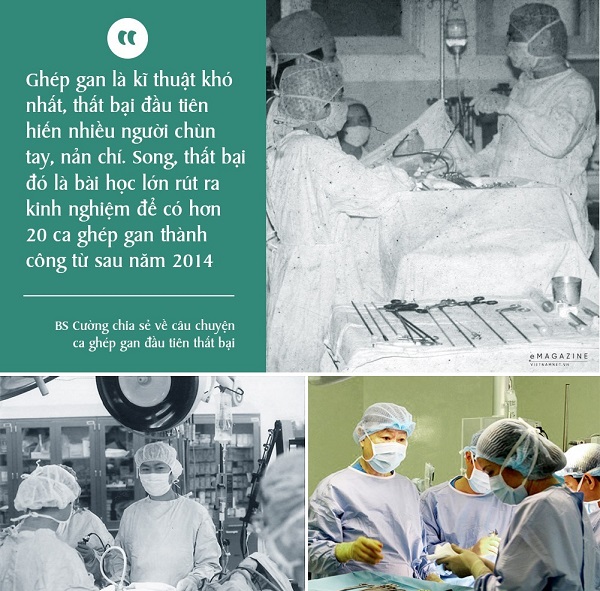
After the first failure, the whole team was shocked and had to stop two years later to start again. “Liver transplantation is the most difficult technique, the first failure that causes many people to back down, frustrated. But that failure is a great lesson to learn from experience for more than 20 successful liver transplants after 2014, ”Dr. Cuong said.
For nearly 40 years, the career of treating people has led Assoc.Prof.Dr. Nguyen Tan Cuong to go through the country's historic paths. Because of the chaotic war, he sought medical care, because after the war, he slipped through the narrow opening to become the first endoscopic surgeon, and the country renewed international cooperation once with his colleagues. accepting liver transplant techniques, before retiring he ceded his position to young people. A self-proclaimed scholar, lifelong learner and researcher, the old doctor sometimes wielded a scalpel when the poor patients clung to him, begging him to return to the doctor's image of more than 30 last year.
Source: Vietnamnet
For appointment or more information about the services provided by General Surgery Department, please contact:
- Nurse Station: (8428) 6280 3333, ext. 8247 or 8246
- Patient service: (8428) 6280 3333, ext. 8242
- Operator: (8428) 6280 3333, ext. 0
- Address: No. 3, 17A Street, Binh Tri Dong B Ward, Binh Tan Dist. (Next to AEON Mall Binh Tan). Ho Chi Minh City.
- Website: https://cih.com.vn/en/
- Email: This email address is being protected from spambots. You need JavaScript enabled to view it.










